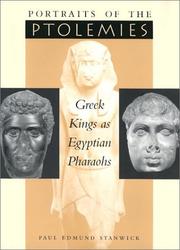| Listing 1 - 10 of 39 | << page >> |
Sort by
|
Book
Year: 1988 Publisher: Bruxelles Musées royaux d'art et d'histoire
Abstract | Keywords | Export | Availability | Bookmark
 Loading...
Loading...Choose an application
- Reference Manager
- EndNote
- RefWorks (Direct export to RefWorks)
Book
Year: 1988 Publisher: Brussel Koninklijke Musea voor Kunst en Geschiedenis
Abstract | Keywords | Export | Availability | Bookmark
 Loading...
Loading...Choose an application
- Reference Manager
- EndNote
- RefWorks (Direct export to RefWorks)
Book
Year: 1998 Publisher: Liège Université de Liège. Faculté de philosophie et lettres
Abstract | Keywords | Export | Availability | Bookmark
 Loading...
Loading...Choose an application
- Reference Manager
- EndNote
- RefWorks (Direct export to RefWorks)
Book
Year: 1979 Publisher: Bruxelles : Fondation égyptologique reine Elisabeth,
Abstract | Keywords | Export | Availability | Bookmark
 Loading...
Loading...Choose an application
- Reference Manager
- EndNote
- RefWorks (Direct export to RefWorks)
Portrait sculpture, Egyptian --- Themes, motives. --- Hatshepsut,
Book
ISBN: 9004459561 9789004459564 9789004432635 9004432639 9789004432635 Year: 2021 Publisher: Boston Brill
Abstract | Keywords | Export | Availability | Bookmark
 Loading...
Loading...Choose an application
- Reference Manager
- EndNote
- RefWorks (Direct export to RefWorks)
"In The Egyptian Elite as Roman Citizens Giorgia Cafici offers the analysis of private, male portrait sculptures as attested in Egypt between the end of the Ptolemaic and the beginning of the Roman Period. Ptolemaic/Early Roman portraits are examined using a combination of detailed stylistic evaluation, philological analysis of the inscriptions and historical and prosopographical investigation of the individuals portrayed. The emergence of this type of sculpture has been contextualised, both geographically and chronologically, as it belongs to a wider Mediterranean horizon. The analysis has revealed that eminent members of the Egyptian elite decided to be represented in an innovative way, echoing of portraits of eminent Romans of the Late Republic, whose identity was surely known in Egypt"--
Portrait sculpture, Egyptian. --- Sculpture, Egyptian. --- Egypt --- History --- Portrait sculpture, Egyptian --- Sculpture, Egyptian
Book
ISBN: 0861590368 Year: 1984 Publisher: London : British Museum,
Abstract | Keywords | Export | Availability | Bookmark
 Loading...
Loading...Choose an application
- Reference Manager
- EndNote
- RefWorks (Direct export to RefWorks)
Portrait sculpture, Egyptian --- Egyptian portrait sculpture --- Tetisheri, --- Portraits.
Book
ISBN: 029270609X Year: 2002 Publisher: Austin, [Texas] : University of Texas Press,
Abstract | Keywords | Export | Availability | Bookmark
 Loading...
Loading...Choose an application
- Reference Manager
- EndNote
- RefWorks (Direct export to RefWorks)
As archaeologists recover the lost treasures of Alexandria, the modern world is marveling at the latter-day glory of ancient Egypt and the Greeks who ruled it from the ascension of Ptolemy I in 306 B.C. to the death of Cleopatra the Great in 30 B.C. The abundance and magnificence of royal sculptures from this period testify to the power of the Ptolemaic dynasty and its influence on Egyptian artistic traditions that even then were more than two thousand years old. In this book, Paul Edmund Stanwick undertakes the first complete study of Egyptian-style portraits of the Ptolemies. Examining one hundred and fifty sculptures from the vantage points of literary evidence, archaeology, history, religion, and stylistic development, he fully explores how they meld Egyptian and Greek cultural traditions and evoke surrounding social developments and political events. To do this, he develops a "visual vocabulary" for reading royal portraiture and discusses how the portraits helped legitimate the Ptolemies and advance their ideology. Stanwick also sheds new light on the chronology of the sculptures, giving dates to many previously undated ones and showing that others belong outside the Ptolemaic period.
Portraits, Hellenistic --- Portrait sculpture, Egyptian --- Themes, motives. --- Ptolemaic dynasty,
Book
ISBN: 9789004459564 9789004432635 Year: 2021 Publisher: Leiden; Boston : BRILL
Abstract | Keywords | Export | Availability | Bookmark
 Loading...
Loading...Choose an application
- Reference Manager
- EndNote
- RefWorks (Direct export to RefWorks)
In The Egyptian Elite as Roman Citizens Giorgia Cafici offers the analysis of private, male portrait sculptures as attested in Egypt between the end of the Ptolemaic and the beginning of the Roman Period. Ptolemaic/Early Roman portraits are examined using a combination of detailed stylistic evaluation, philological analysis of the inscriptions and historical and prosopographical investigation of the individuals portrayed. The emergence of this type of sculpture has been contextualised, both geographically and chronologically, as it belongs to a wider Mediterranean horizon. The analysis has revealed that eminent members of the Egyptian elite decided to be represented in an innovative way, echoing the portraits of eminent Romans of the Late Republic, whose identity was surely known in Egypt.
Portrait sculpture, Egyptian --- Sculpture, Egyptian --- Egypt --- History --- Egyptian sculpture --- Egyptian portrait sculpture --- Portrait sculpture, Egyptian. --- Sculpture, Egyptian.
Book
Year: 1988 Publisher: Birmingham, Ala. : The Museum,
Abstract | Keywords | Export | Availability | Bookmark
 Loading...
Loading...Choose an application
- Reference Manager
- EndNote
- RefWorks (Direct export to RefWorks)
Portrait sculpture, Egyptian --- Portrait sculpture, Egyptian --- Sculpture de portraits égyptienne --- Sculpture de portraits égyptienne --- Exhibitions. --- Exhibitions --- Expositions --- Expositions

ISBN: 0292777728 Year: 2002 Publisher: Austin University of Texas
Abstract | Keywords | Export | Availability | Bookmark
 Loading...
Loading...Choose an application
- Reference Manager
- EndNote
- RefWorks (Direct export to RefWorks)
Portrait sculpture, Egyptian --- Portraits, Hellenistic --- Hellenistic portraits --- Egyptian portrait sculpture --- Themes, motives --- Ptolemaic dynasty,
| Listing 1 - 10 of 39 | << page >> |
Sort by
|

 Search
Search Feedback
Feedback About UniCat
About UniCat  Help
Help News
News